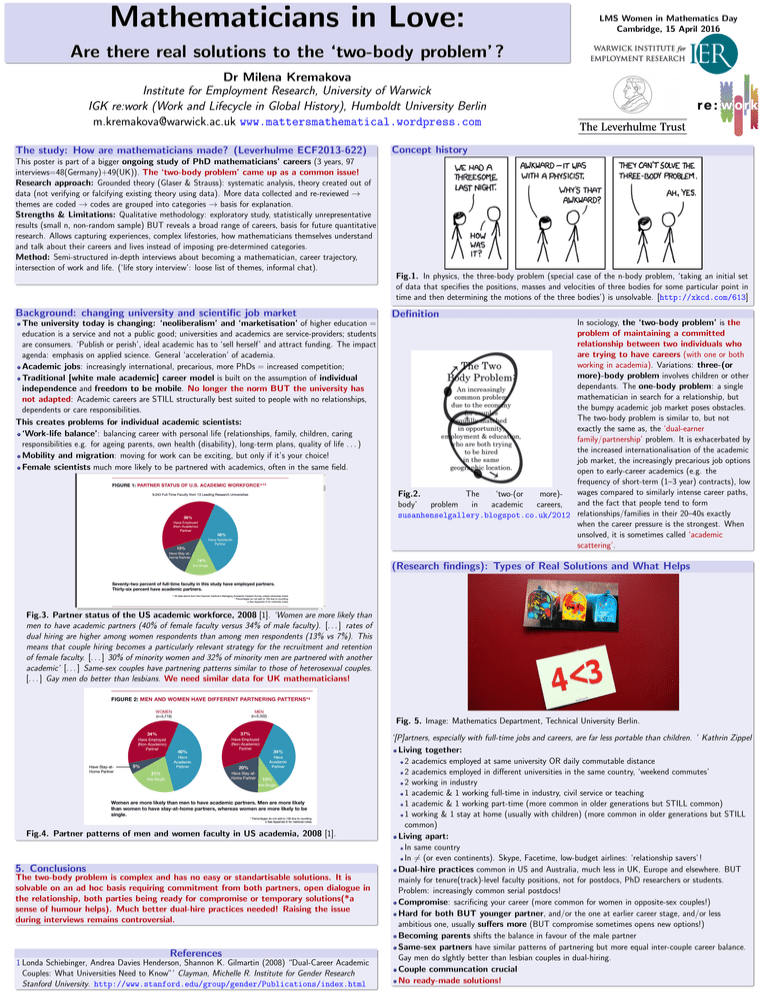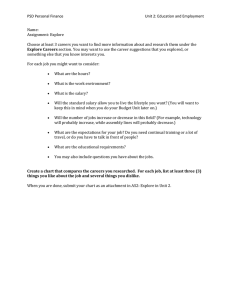Mathematicians in Love:
advertisement

Mathematicians in Love: LMS Women in Mathematics Day Cambridge, 15 April 2016 Are there real solutions to the ‘two-body problem’ ? Dr Milena Kremakova Institute for Employment Research, University of Warwick IGK re:work (Work and Lifecycle in Global History), Humboldt University Berlin m.kremakova@warwick.ac.uk www.mattersmathematical.wordpress.com The study: How are mathematicians made? (Leverhulme ECF2013-622) Concept history This poster is part of a bigger ongoing study of PhD mathematicians’ careers (3 years, 97 interviews=48(Germany)+49(UK)). The ‘two-body problem’ came up as a common issue! Research approach: Grounded theory (Glaser & Strauss): systematic analysis, theory created out of data (not verifying or falcifying existing theory using data). More data collected and re-reviewed → themes are coded → codes are grouped into categories → basis for explanation. Strengths & Limitations: Qualitative methodology: exploratory study, statistically unrepresentative results (small n, non-random sample) BUT reveals a broad range of careers, basis for future quantitative research. Allows capturing experiences, complex lifestories, how mathematicians themselves understand and talk about their careers and lives instead of imposing pre-determined categories. Method: Semi-structured in-depth interviews about becoming a mathematician, career trajectory, intersection of work and life. (‘life story interview’: loose list of themes, informal chat). Fig.1. In physics, the three-body problem (special case of the n-body problem, ‘taking an initial set of data that specifies the positions, masses and velocities of three bodies for some particular point in time and then determining the motions of the three bodies’) is unsolvable. [http://xkcd.com/613] Background: changing university and scientific job market The university today is changing: ‘neoliberalism’ and ‘marketisation’ of higher education = education is a service and not a public good; universities and academics are service-providers; students are consumers. ‘Publish or perish’, ideal academic has to ‘sell herself’ and attract funding. The impact agenda: emphasis on applied science. General ‘acceleration’ of academia. Academic jobs: increasingly international, precarious, more PhDs = increased competition; Traditional [white male academic] career model is built on the assumption of individual independence and freedom to be mobile. No longer the norm BUT the university has not adapted: Academic careers are STILL structurally best suited to people with no relationships, dependents or care responsibilities. This creates problems for individual academic scientists: ‘Work-life balance’: balancing career with personal life (relationships, family, children, caring responsibilities e.g. for ageing parents, own health (disability), long-term plans, quality of life . . . ) Mobility and migration: moving for work can be exciting, but only if it’s your choice! Female scientists much more likely to be partnered with academics, often in the same field. Definition In sociology, the ‘two-body problem’ is the problem of maintaining a committed relationship between two individuals who are trying to have careers (with one or both working in academia). Variations: three-(or more)-body problem involves children or other dependants. The one-body problem: a single mathematician in search for a relationship, but the bumpy academic job market poses obstacles. The two-body problem is similar to, but not exactly the same as, the ‘dual-earner family/partnership’ problem. It is exhacerbated by the increased internationalisation of the academic job market, the increasingly precarious job options open to early-career academics (e.g. the frequency of short-term (1–3 year) contracts), low wages compared to similarly intense career paths, Fig.2. The ‘two-(or more)and the fact that people tend to form body’ problem in academic careers, susanhenselgallery.blogspot.co.uk/2012 relationships/families in their 20–40s exactly when the career pressure is the strongest. When unsolved, it is sometimes called ‘academic scattering’. (Research findings): Types of Real Solutions and What Helps Fig.3. Partner status of the US academic workforce, 2008 [1]. ‘Women are more likely than men to have academic partners (40% of female faculty versus 34% of male faculty). [. . . ] rates of dual hiring are higher among women respondents than among men respondents (13% vs 7%). This means that couple hiring becomes a particularly relevant strategy for the recruitment and retention of female faculty. [. . . ] 30% of minority women and 32% of minority men are partnered with another academic’ [. . . ] Same-sex couples have partnering patterns similar to those of heterosexual couples. [. . . ] Gay men do better than lesbians. We need similar data for UK mathematicians! Fig. 5. Image: Mathematics Department, Technical University Berlin. Fig.4. Partner patterns of men and women faculty in US academia, 2008 [1]. 5. Conclusions The two-body problem is complex and has no easy or standartisable solutions. It is solvable on an ad hoc basis requiring commitment from both partners, open dialogue in the relationship, both parties being ready for compromise or temporary solutions(*a sense of humour helps). Much better dual-hire practices needed! Raising the issue during interviews remains controversial. References 1 Londa Schiebinger, Andrea Davies Henderson, Shannon K. Gilmartin (2008) “Dual-Career Academic Couples: What Universities Need to Know”’ Clayman, Michelle R. Institute for Gender Research Stanford University. http://www.stanford.edu/group/gender/Publications/index.html ‘[P]artners, especially with full-time jobs and careers, are far less portable than children. ’ Kathrin Zippel Living together: 2 academics employed at same university OR daily commutable distance 2 academics employed in different universities in the same country, ‘weekend commutes’ 2 working in industry 1 academic & 1 working full-time in industry, civil service or teaching 1 academic & 1 working part-time (more common in older generations but STILL common) 1 working & 1 stay at home (usually with children) (more common in older generations but STILL common) Living apart: In same country In 6= (or even continents). Skype, Facetime, low-budget airlines: ‘relationship savers’ ! Dual-hire practices common in US and Australia, much less in UK, Europe and elsewhere. BUT mainly for tenure(track)-level faculty positions, not for postdocs, PhD researchers or students. Problem: increasingly common serial postdocs! Compromise: sacrificing your career (more common for women in opposite-sex couples!) Hard for both BUT younger partner, and/or the one at earlier career stage, and/or less ambitious one, usually suffers more (BUT compromise sometimes opens new options!) Becoming parents shifts the balance in favour of the male partner Same-sex partners have similar patterns of partnering but more equal inter-couple career balance. Gay men do slghtly better than lesbian couples in dual-hiring. Couple communcation crucial No ready-made solutions!



